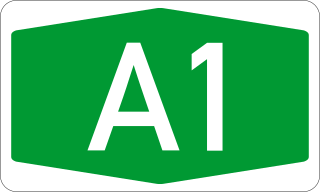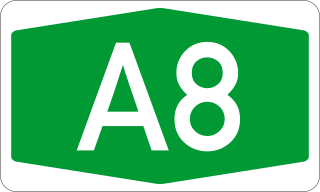
The National Roads and Motorways in Greece constitute the main road network of the country. These two types of roads are distinct in terms of their construction specifications. Their main difference is that motorways adhere to higher quality construction standards than National Roads.

Motorway 1 (code: A1, also known as Athens-Thessaloniki-EvzonoiMotorway, and previously as Patras-Athens-Thessaloniki-EvzonoiMotorway the 2nd longest motorway in Greece with a length of 550 km. It is the principal north–south road connection in Greece, connecting the country's capital Athens with the regions of Thessaly and Macedonia, as well as the country's second largest city, Thessaloniki. It starts from Neo Faliro in Attica and continues north to reach the Evzonoi border station, on the Greek border with North Macedonia.

The Thessaloniki Metro is an underground rapid-transit system under construction in Thessaloniki, Greece's second largest city. Estimates for the cost of the megaproject are €1.62 billion ($1.83 billion) for the main line and €640 million ($723 million) for the Kalamaria extension, for a total of €2.26 billion ($2.55 billion). The project is primarily funded with loans from the European Investment Bank (EIB) and the European Regional Development Fund (ERDF) and funds from the Greek government. Construction by a Greek-Italian consortium is overseen by Elliniko Metro S.A., the Greek state-owned company which oversaw construction of the Athens Metro and Athens Tram.
An underwater tunnel is a tunnel which is partly or wholly constructed under the sea or a river. They are often used where building a bridge or operating a ferry link is unviable, or to provide competition or relief for existing bridges or ferry links. While short tunnels are often road tunnels which may admit motorized traffic, unmotorized traffic or both, concerns with ventilation lead to the longest tunnels being electrified rail tunnels.

The Greek Motorway 5 is a motorway in Greece. The motorway, commonly referred to as Ionia Odos or Ionia Motorway, starts at Ioannina and it follows the western coastline of mainland Greece down to the Gulf of Corinth. At Rio, it crosses the gulf via the Rio–Antirrio bridge and is connected with the A8 Motorway at an interchange near Patras. The future, currently under construction, Patras - Pyrgos motorway is typically part of the A5 Motorway.

The Salamis Naval Base is the largest naval base of the Hellenic Navy. It is located in the northeastern part of Salamis Island, Greece and in Amphiali and Skaramangas. It is close to the major population centre of Athens.

The Greek Motorway 8, is a motorway in Greece. Part of the Olympia Odos network, the motorway connects Athens with Patras in southwestern Greece, spanning a total of 215 km (134 mi).

Motorway 3 (A3), or the Central Greecemotorway is a partially completed motorway in Greece. It will lead from the Motorway 1 near Lamia to the Motorway 2 near Grevena, passing Karditsa, Trikala and Kalambaka. It will carry the European route E65.

The Agia Sophia Stadium, also known as OPAP Arena for sponsorship reasons and as AEK Arena for UEFA competitions, is the home stadium of AEK Athens. With an all-seater capacity of 32,500, it is the third largest football stadium overall in Greece. It is located in Nea Filadelfeia, a northwestern suburb of Athens, Greece. The new arena was built on the site of the former Nikos Goumas Stadium stadium. The construction of the arena was completed in October 2022. Agia Sophia Stadium is the newest stadium built in Greece.
The Famagusta derby refers to the Famagusta's local derby, football matches played between Anorthosis Famagusta and Nea Salamis Famagusta. It is one of the rivalries of Cypriot football. The rivalry is also indicative of social, cultural and political differences.

Line 1 of the Thessaloniki Metro, also known as the Base Project, is a deep-level underground rapid transit line in Thessaloniki, Greece, connecting N. Sid. Stathmos in the west with Nea Elvetia in the east, before continuing on to the Pylaia depot. The line was set to open in 2023. Discovery of historical sites in 2019 halted work for 28 months while excavations took place. Of the line's 13 stations, 11 are also stops for Thessaloniki Metro's Line 2, as they will share tunnels.

Line 2 of the Thessaloniki Metro, also known as the Kalamaria Extension, is a deep-level underground rapid transit line in Thessaloniki, Greece, connecting N. Sid. Stathmos in the west with Mikra in the south-east. The section of the line between Neos Sidirodromikos Stathmos and 25 Martiou stations is set to open in 2023, with the rest of the line becoming operational in 2024. Of the line's 16 stations, 11 are also stops for Thessaloniki Metro's Line 1, as they will share tunnels.
In the run-up to the May 2023 Greek legislative election, various organizations carry out opinion polling to gauge voting intention in Greece during the term of the 18th Hellenic Parliament. Results of such polls are displayed in this article. The date range for these opinion polls is from the previous legislative election, held on 7 July 2019, to the day the next election was held, on 21 May 2023.
The 2018–19 season was Pafos's 5th year in existence, and second season in the Cypriot First Division.
Anafi Municipal Airport is an airport currently under construction in the island of Anafi, Greece, in the Cyclades islands region. Located approximately 5 km (3.1 mi) west of the island principal town, the Greek government approved its construction on 2004. It is expected to be finished by the end of 2023.











